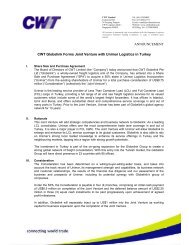notes to the financial statements - Investor Relations
notes to the financial statements - Investor Relations
notes to the financial statements - Investor Relations
You also want an ePaper? Increase the reach of your titles
YUMPU automatically turns print PDFs into web optimized ePapers that Google loves.
CWT Limited<br />
74<br />
NOTES TO THE FINANCIAL STATEMENTS<br />
YEAR ENDED 31 DECEMBER 2011<br />
3 SIGNIFICANT ACCOUNTING POLICIES (CONT’D)<br />
3.17 Income tax expense (cont’d)<br />
Deferred tax is recognised in respect of temporary differences between <strong>the</strong> carrying amounts of assets and liabilities for<br />
<strong>financial</strong> reporting purposes and <strong>the</strong> amounts used for taxation purposes. Deferred tax is not recognised for <strong>the</strong> temporary<br />
differences arising from <strong>the</strong> initial recognition of assets or liabilities in a transaction that is not a business combination and<br />
that affects nei<strong>the</strong>r accounting nor taxable profit or loss, and temporary differences related <strong>to</strong> investments in subsidiaries<br />
and jointly-controlled entities <strong>to</strong> <strong>the</strong> extent that it is probable that <strong>the</strong>y will not reverse in <strong>the</strong> foreseeable future. In addition,<br />
deferred tax is not recognised for taxable temporary differences arising on <strong>the</strong> initial recognition of goodwill. Deferred tax is<br />
measured at <strong>the</strong> tax rates that are expected <strong>to</strong> be applied <strong>to</strong> <strong>the</strong> temporary differences when <strong>the</strong>y reverse, based on <strong>the</strong> laws<br />
that have been enacted or substantively enacted by <strong>the</strong> reporting date. Deferred tax assets and liabilities are offset if <strong>the</strong>re<br />
is a legally enforceable right <strong>to</strong> offset current tax liabilities and assets and <strong>the</strong>y relate <strong>to</strong> income taxes levied by <strong>the</strong> same tax<br />
authority on <strong>the</strong> same taxable entity, or on different tax entities, but <strong>the</strong>y intend <strong>to</strong> settle current tax liabilities and assets on a<br />
net basis or <strong>the</strong>ir tax assets and liabilities will be realised simultaneously.<br />
A deferred tax asset is recognised <strong>to</strong> <strong>the</strong> extent that it is probable that future taxable profits will be available against which<br />
temporary differences can be utilised. Deferred tax assets are reviewed at each reporting date and are reduced <strong>to</strong> <strong>the</strong> extent<br />
that it is no longer probable that <strong>the</strong> related tax benefit will be realised.<br />
In <strong>the</strong> ordinary course of business, <strong>the</strong>re are many transactions and calculations for which <strong>the</strong> ultimate tax treatment is<br />
uncertain. Therefore, <strong>the</strong> Group recognises tax liabilities based on estimates of whe<strong>the</strong>r additional taxes and interest will be<br />
due. These tax liabilities are recognised when <strong>the</strong> Group believes that certain positions may not be fully sustained upon review<br />
by tax authorities, despite <strong>the</strong> Group’s belief that its tax return positions are supportable. The Group believes that its accruals<br />
for tax liabilities are adequate for all open tax years based on its assessment of many fac<strong>to</strong>rs including interpretations of tax<br />
law and prior experience. This assessment relies on estimates and assumptions and may involve a series of multifaceted<br />
judgements about future events. New information may become available that causes <strong>the</strong> Group <strong>to</strong> change its judgement<br />
regarding <strong>the</strong> adequacy of existing tax liabilities, such changes <strong>to</strong> tax liabilities will impact tax expense in <strong>the</strong> period that such<br />
a determination is made.<br />
3.18 Earnings per share<br />
The Group presents basic and diluted earnings per share data for its ordinary shares. Basic earnings per share is calculated<br />
by dividing <strong>the</strong> profit or loss attributable <strong>to</strong> ordinary shareholders of <strong>the</strong> Company by <strong>the</strong> weighted average number of ordinary<br />
shares outstanding during <strong>the</strong> year, adjusted for own shares held. Diluted earnings per share is determined by adjusting<br />
<strong>the</strong> profit or loss attributable <strong>to</strong> ordinary shareholders and <strong>the</strong> weighted average number of ordinary shares outstanding,<br />
adjusted for own shares held, for <strong>the</strong> effects of all dilutive potential ordinary shares, which comprise share options granted <strong>to</strong><br />
employees.<br />
3.19 Segment reporting<br />
An operating segment is a component of <strong>the</strong> Group that engages in business activities from which it may earn revenues and<br />
incur expenses, including revenues and expenses that relate <strong>to</strong> transactions with any of <strong>the</strong> Group’s o<strong>the</strong>r components. All<br />
operating segments’ operating results are reviewed regularly by <strong>the</strong> Group CEO <strong>to</strong> make decisions about resources <strong>to</strong> be<br />
allocated <strong>to</strong> <strong>the</strong> segment and assess its performance, and for which discrete <strong>financial</strong> information is available.<br />
Segment results that are reported <strong>to</strong> <strong>the</strong> Group CEO include items directly attributable <strong>to</strong> a segment as well as those<br />
that can be allocated on a reasonable basis. Unallocated items comprise mainly corporate assets and liabilities, business<br />
development costs and corporate expenses arising from group functions.<br />
Segment capital expenditure is <strong>the</strong> <strong>to</strong>tal costs incurred during <strong>the</strong> year <strong>to</strong> acquire property, plant and equipment, and<br />
intangible assets o<strong>the</strong>r than goodwill.





